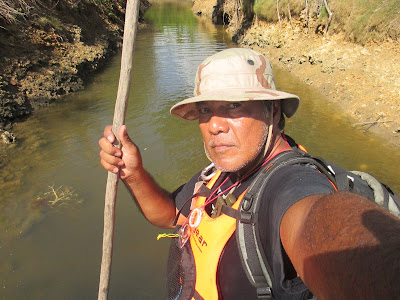OUTDOOR COMMON
SENSE TIPS: When choosing a walking staff
while hiking outdoors, choose one that is taller than your head. The taller
stick would remove the possibility of getting poked on the throat, on the face
or on one of your eyes when you slip from the trail, especially when you are
placing the lower end of the stick on a lower slope. That way the stick would
still be much higher than you or go level with the top of your head.
Do not cut a green limb. Our forest has lots of that left by wood gatherers and farmers. If you think you need it very badly and nothing to pick up along the trail, choose from a madre de cacao (kakawati) shrub. It is an introduced species from Central America. The more you cut the more it thrive.
First seen in Facebook
December 31, 2017
=> => => o0o <= <= <=
THREE POINTS
OF CONTACT to the ground is the best and the most stable balance you can get
when walking the backcountry and you can most appreciate that when you are
treading on difficult terrain of steep inclines downhill where surface grounds
are loose. The feet, the ankles, the knees and the hip joints would benefit
tremendously from the shifting of the weight to a third “leg”, in this case, a
walking staff.
It is a piece
of wood that is almost straight, about a foot taller over you which you would
ordinarily find in the countryside and just as expendable when you do not need
it. It could be dry or a still green stick but not a dead wood. It is
everywhere and not for sale. It could be found on the ground or left standing
beside a tree trunk or it could be part of a bundle of sticks that would soon
become firewood.
Its length you
could appreciate well when you would find the extra leverage as you set the
stick below the height of where your feet is standing upon. When in that
position you could retain your balance well since you shift part of your weight
to the stick while maintaining an erect position unlike a shorter stick where
you need to bend forward along with your weight to reach down.
The rod’s
length also would not threaten nor interfere on your face and neck should you slip.
Some accidents to the face and the neck, very vital parts, happen when the
stick used was shorter. We must avoid, as much as possible, injuries to those
parts of our body. The longer reach gives us advantage when poking places you
suspect as dangerous to step on or something venomous lying underneath grass.
In semi-arctic
regions, the extra length of staffs are much favored by adventurers and snow
travelers for the longer reach could test the rigidness of ice on water from a
safe distance, especially when crossing streams and marshes. You could also
wedge it across the edges when falling into a hole caused by brittle ice or on
a waterlogged ground.
Cutting a green limb is a last resort but it is heavier than the one that was cut several days old. Choose invasive species or an introduced tree. We have many but be on the lookout for the Mexican lilac tree (kakawati) because it is the best to use. Branches grow straight and it loves to be cut like a mythical Hydra. Like the kakawati, bamboo grows fast when one is cut. Choose the buho or the bagakay variety. Although hollow, but they are lighter and tough.
=> => => o0o <= <= <=
WARRIOR
PILGRIMAGE BLOG, personified by this writer, is synonymous with the Outdoors,
since Bushcraft and Survival is its niche. Safety and Security are its bedrock
when it ventured into organizing outdoor events that involved people as in
adventure/pilgrimage guideships and seminars; and explorations and expeditions.
Through
tutorship, experience, folk knowledge and good old common sense, this writer
was able to collect useful information which he is currently documenting in a
book titled, ETHICAL BUSHCRAFT. He shares some of this information and
knowledge in his training sessions; in his social-media account; and in this
blog.
Photo Nr 1 courtesy of Michael Schwarz
Photo Nr 2 courtesy of Christopher Ngosiok





































No comments:
Post a Comment